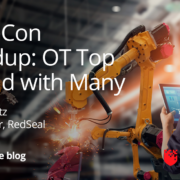InfoSeCon Roundup: OT Top of Mind with Many
The RedSeal team recently attended the sold-out ISSA Triangle InfoSeCon in Raleigh. It was energizing to see and talk to so many people in person. People were excited to be at in-person events again (as were we!) and we had some great discussions at our booth on how RedSeal can help customers understand their environment and stay one step ahead of threat actors looking to exploit existing vulnerabilities.
Visibility was a top topic at the booth, but I want to focus this blog on our panel discussion, titled ”OT: Still a Security Blindspot”, which, of course, has visibility as a core need. While I was expecting that this topic would be of interest to quite a few attendees, I was not expecting the great reception we received, nor the number of people that stayed behind to talk to us. We had so many great questions, that we have decided to host a webinar with the same title, where we will share some of the same information, and expand it to address some additional topics based on attendee interest.
I want to highlight some key points we shared during the session:
We started the session talking about OT networks – what they are, and how they exist across all verticals in some way, shape or form (it is not just manufacturers!). We did share a life sciences customer example to close the session (think about all of the devices in a hospital connected to the Internet – and what could happen if they were hacked!).
Then we got into the “risk” part of the discussion. We shared how OT networks are targeted via vulnerable devices and highlighted actual consequences from some real-life examples. We focused on the Mirai botnet and potential motives from threat actors:
- Botnets can simply to be annoying or attention getting, interrupting business
- Ransomware has traditionally been for cash or equivalent, but now can also be for deliberate intentional damage
- Nation State – with espionage as a goal – to disrupt or compromise organizations or governments
Our panelists from Medigate by Claroty provided their perspective based on discussions with their customers. They explained that for many organizations OT was an afterthought when accessing security risks. The audience appeared to agree with this assessment. Unfortunately, this meant that OT has often been the quickest way to cause serious damage at an organization. They have seen this within the 1500+ hospitals they work with. They shared a couple of examples, which clearly demonstrated what can happen if you have vulnerable OT devices:
- Turning off the air conditioning at a hospital in Phoenix AZ during the summer shut EVERYTHING down
- Operating rooms must be kept at very specific temps and humidity levels. A customer in CA whose dedicated O.R. HVAC was impacted ended up losing $1M in revenue PER DAY while it was down
One of the reasons that the security risks for OT devices has not been addressed as well as they should is that OT devices have typically been managed by the Facilities organizations, who do not have the training and expertise needed for this task. We did spend some time talking about who “owns” managing and securing these OT devices. Luckily, there is growing awareness of the need for visibility into both OT and IT devices as part of an overall security strategy, and there are emerging solutions to address this need.
We also spent time discussing how complex managing OT/IT becomes when companies have distributed sites or complex supply chains. The Medigate panelists shared how some of their Life Sciences customers have sites with different OT network topologies, and some even have a mismatch between the topology of the individual site and its production logic. This means there are usually multiple redundant, unmonitored connections at each site, which provides threat actors with numerous opportunities to penetrate the OT network and, once inside, to move laterally within it.
This led to a conversation among the panelist on how to address the IT/OT visibility needs:
- First step: gain visibility into where OT is and then integrate it with existing IT security infrastructure
- Ongoing: alignment and collaboration between and across IT and OT security, as well as with a range of third-party vendors, technicians, and contractors
- End goal: enable all teams (facilities, IT, security, networking, etc.) speak the same language from the same source of truth
The above is just a brief review of some of the topics covered during the panel discussion. If you are interested in hearing more about how to address IT/OT visibility needs and hear about how customers are addressing these needs or find out more about RedSeal, please visit our website or contact us today!




